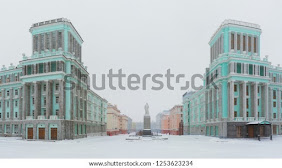For research into my work I have looked at a variety of several languages or mediums in classical architecture. These are Art Deco, Beaux Art, Renaissance, Eclecticism, Neo-classical and Egyptian.
ART DECO -
It was a movement in the decorative arts and architecture that originated in the 1920's and gained mass precedence in Western Europe and the United States. Its name was derived from an exhibition held in Paris 1925 - the Exposition Internationale des Arts Décoratifs et Industriels Modernes. The features of this expression were influenced by cubism, Art Nouveau, American Indian, Egyptian and Early classical sources.
The distinguishing features are often sharp/streamlined looking, ornate in its geometry and stylized/unusual forms. Design sometimes followed a repetitive pattern and had symmetrical elements. Materials were often expensive, ranging from natural ones like; jade, chrome, silver and limestone, and further substances which were artificial, like - vita-glass and ferroconcrete.
Repeat patterns and Geometry synonymous with Art Deco
Art Deco architecture -

Beaux Art -
This style, birthed from French Baroque architecture or French classicism, was created in the 1830's. Beaux Art was an innovative language, created by 4 Architects Joseph-Louis Duc, Félix Duban, Henri Labrouste and Léon Vaudoyer who were students of the Académie des Beaux-Arts. After each won the Prix de Rome consecutively from 1823 - 1826 this allowed them to further study together in Rome at the Villa Medici, where they would begin to craft their innovative and unorthodox expression in architecture.
Elements of Beaux Art emanated from Baroque, Renaissance, Gothic and Romanesque architecture as the 4 architects aimed to create an unique French style. 2 architects Labrouste and Duban in the group, tried to express a national or regional expression of architecture. As Labrouste argued, "a building should reflect and express the specific region in which it is built" and Duban advocated for "the importance of achieving a national character in architecture."
Their avante-garde style had antagonists earlier on from the Académie des Beaux-Arts. However it would quickly spread through the academy and would be accepted as the new refinement to the previous style,


Renaissance -
Renaissance architecture was the revival or re-awakening from the influence of Greek and Roman architectural features, materials and thought between the early 15th and 17th century. It was started in Florence Italy,
with Filippo Brunelleschi as one of its innovators but spread and gained recognition across Europe. Placing an emphasis on geometry, symmetry and proportion as influenced from the deep mastery of classical antiquity, ancient Roman architecture in particular but creating its own aesthetic.
It stylistically followed from Gothic architecture and was succeeded by Baroque architecture. The style also became more decorative and ornamental with a widespread use of statuary, domes and cupolas with its own unique twist on characteristics/concepts in facades, columns and pilasters, arches, vaults, domes, windows, and walls.
Eclecticism -
An architectural style which gained prominence from the 19th to 20th century, its meaning was the incorporation of several elements of previous historical or classical styles to create something new or not seen before. These elements may include structural features, furniture, decorative motives, distinct historical ornament, traditional cultural motifs or styles from other countries.
From mixing and combining several styles architects were able to have more freedom of expression in their work which provided an endless source of inspiration.
Eclecticism first emerged out of Europe, from styles such as Beaux Art from France and Britain's Victorian architecture but was most influential in America.


Neo-classical -
Architecture which began in the 18th century, it was heavily influenced by classical Greek, Roman Architecture, Renaissance and Baroque, created as a response towards the elaborate style of the Rococo of that period.
It was first expressed in France by architects like Ange-Jacques Gabriel who was the premier architect at Versailles and his designs for the royal palace would dominate mid 18th century architecture.
The characteristics include simplicity in geometric forms, the Greek (particularly Doric) detailing, dramatic columns, and blank walls. The style, projections and designs on the building were much flatter which created different effects of light and shade. sculptural elements and bas-reliefs were also much flatter and often framed in friezes, tablets or panels.This made individual features on the building more isolated and created a sense of completeness, rather than being integrated with other features.


Egyptian/Nubian -
Created mainly during the dynastic periods at the first three millennia BCE along the Nile valley regions of Egypt and Nubia.
Most studies of Egyptian and Nubian architecture are weighted in favor of funerary and religious buildings. They built tombs, temples and palaces, and the two main building materials were unbaked brick, limestone, granite and sandstone.
Egyptian columns are diverse and range from 16 sides polygon to circular columns. Imhotep, the ancient Egyptian architect was known to carve stone columns resembling bundled reeds and other plants. The columns were placed closer to ensure they can carry the heavy weight of the stone roof beams.
buffaloah.com
designingbuildings.co.uk
oxfordreference.com
britannica.com
creativemarket.com
hisour.com
visual-arts-cork.com



































Comments
Post a Comment